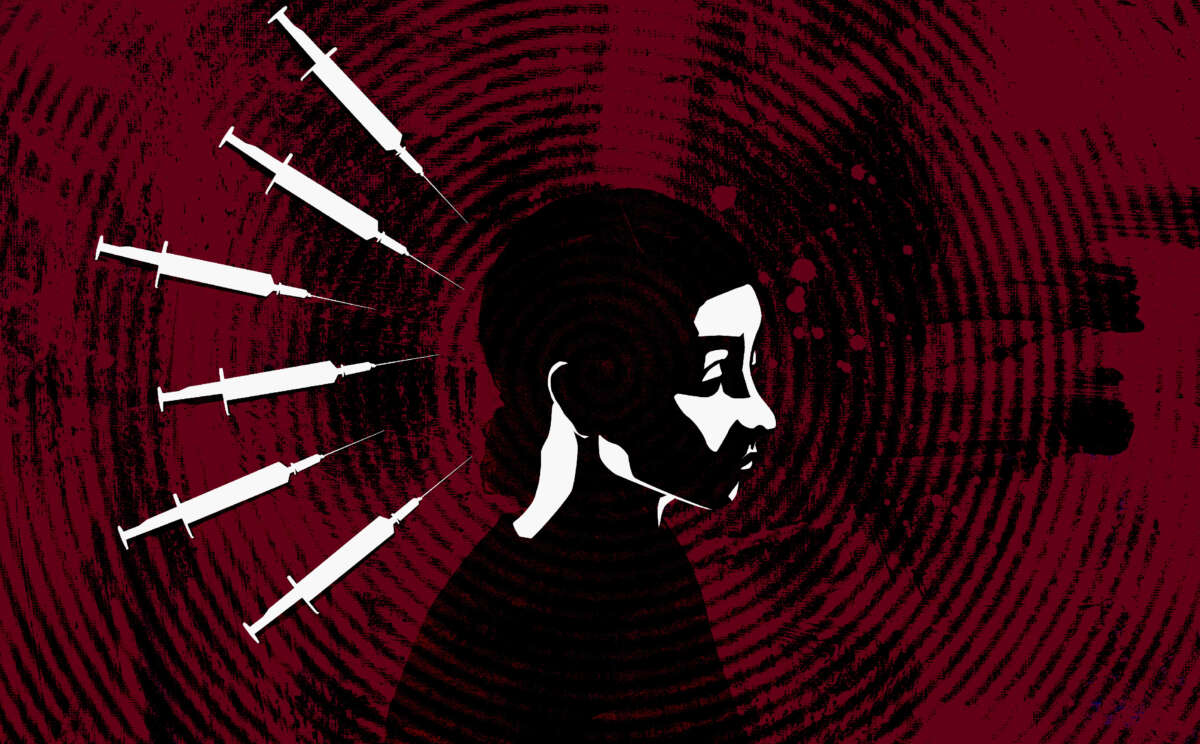Truthout is a vital news source and a living history of political struggle. If you think our work is valuable, support us with a donation of any size.
The documentary record of “mind control” experiments conducted by the United States and other governments during the Cold War is just the tip of the iceberg, and our collective ignorance is by design. In early 1973, as the fallout from the Watergate scandal exposed the need for greater congressional oversight of U.S. intelligence agencies, the head of the Central Intelligence Agency (CIA) ordered the destruction of all documents related to MK Ultra.
Launched in the wake of the Nuremberg Trials, which exposed the extent of Nazi atrocities carried out in the name of science, MK Ultra involved a range of grotesque experiments on unwitting test subjects within and beyond U.S. borders. Newly revealed evidence exposes previously hidden links between MK Ultra experiments on Indigenous children in Canada and imprisoned Black people in the U.S.
On April 20, 2023, a group of Indigenous women known as the Kanien’kehà:ka Kahnistensera (Mohawk Mothers) achieved a milestone in their ongoing lawsuit against several entities, including McGill University, the Canadian government and the Royal Victoria Hospital in Quebec. The parties reached an agreement whereby archeologists and cultural monitors would begin the process of searching for unmarked graves, which the Mohawk Mothers believe are buried on the grounds of the hospital.
Get our free emails
Over the preceding two years, approximately 1,300 unmarked graves, most of them containing the remains of Indigenous children, have been discovered on the grounds of five of Canada’s former residential schools. Throughout the 20th century, the residential school system — like the Indian Boarding School system, its U.S. counterpart — separated thousands of Indigenous children from their families, stripped them of their language and subjected them to various forms of abuse amounting to what a truth and reconciliation commission called “cultural genocide.” But as these horrific revelations demonstrate, the harm wasn’t only cultural — a 1907 investigation found that nearly one-fourth of school attendees did not survive graduation.
In October of 2021, new evidence surfaced linking disappeared Indigenous children to MK Ultra experiments conducted by CIA-sponsored researchers. A white Winnipeg resident named Lana Ponting testified in Quebec’s Superior Court that in 1958, when she was 16 years old, doctors from the Allan Memorial Institute, a former psychiatric hospital affiliated with McGill and the Royal Victoria Hospital, held her against her will, drugged her with LSD and other substances, subjected her to electroshock treatments, and exposed her to auditory indoctrination: playing a recording telling Ponting over and over again, that she was either “a bad girl” or “a good girl.”
Ponting also testified that “some of the children I saw there were Indigenous,” and that she befriended an Indigenous girl named Morningstar, who endured many of the same abuses, with the added indignity of being harassed because of her race. During a reprieve from her drug-induced haze, Ponting recalls sneaking out at night and happening upon “people standing over by the cement wall” with shovels and flashlights. She and other children had heard rumors that bodies were buried on the property. “I believe that some of them would be Indigenous people,” Ponting told the court.
Not only does her testimony corroborate what another Allan Memorial Institute survivor told historian Donovan King a decade earlier, but in 2008, the Squamish Nation included the psychiatric hospital in a list of potential sites containing unmarked graves.
The CIA, along with the U.S. and Canadian military and powerful U.S. charitable foundations, are directly implicated in this ordeal. According to John Mark’s 1991 book The Search for the Manchurian Candidate and Steven Kinzer’s 2019 book Poisoner in Chief, in 1977, in response to a Freedom of Information Act (FOIA) request, CIA archivists uncovered a previously hidden box of MK Ultra financial records revealing, among other things, that the Memorial Institute was home to MK Ultra “Subproject 68.” Under the leadership of psychiatrist Ewen Cameron, whom Ponting accused of raping her, experiments in this subproject sought to “depattern” people’s minds using violent methods Cameron termed “psychic driving.”
Although Cameron is among the most infamous MK Ultra doctors, he was not alone at McGill. As historian Alfred McCoy has shown in his 2006 book A Question of Torture, the sensory deprivation research of Donald Hebb, a McGill psychologist, was also covertly sponsored by the CIA.
“I feel like we’re closer to having our future generations heard, our past generations heard, and whatever has happened to our children that they have purpose,” remarked Kwetiio, after she and the other Mohawk Mothers won an injunction to halt construction near the potential grave sites. As part of their struggle to uncover the truth, the mothers and their supporters have been collecting archival documents related to McGill experiments. Although none of them incontrovertibly prove their suspicions, the court’s recent injunction compelling McGill to expedite the release of restricted files has generated optimism that more pieces of the puzzle will soon come to light.
But what the Mohawk Mothers and their allies have found is compelling, particularly for me: I have spent the last several years researching the history of “behavior modification” programs in U.S. prisons. My forthcoming book Tip of the Spear: Black Radicalism, Prison Repression, and the Long Attica Revolt (available in October 2023), uncovers the roots of the modern prison abolitionist movement and state efforts to destroy it during the 1960s and 1970s. It details a little-known program of prison-based scientific experimentation that intersects with the Mohawk Mothers struggle.
In 1966, New York Gov. Nelson Rockefeller, whose family foundation helped establish the Allan Memorial Institute, launched a partnership whereby a team of McGill consultants were brought to New York to establish programs and conduct research at the Dannemora State Hospital for the Criminally Insane, according to Canadian psychiatrist Bruno Cormier’s 1975 book The Watcher and the Watched. Located in a remote hamlet 25 miles south of New York’s northernmost border with Quebec, the institution confined prisoners who were transferred from other state facilities after being deemed “insane” by prison doctors.
The official purpose of the collaboration was to develop new methods for preventing recidivism. However, the program hosted “experimental studies of various aspects of criminal behavior,” noted a report from 1968. The following year an attendee of a conference about the program noted that a large number of its participants were Black.
An affidavit authored by anthropologist Phillippe Blouin in support of the Mohawk Mothers identified the late psychiatrist Cormier as a person of interest. Blouin located correspondence between lead “Subproject 68” psychologist Cameron and Cormier, who worked as a clinician at the Allan Memorial Institute during the 1950s and 1960s. Authored between 1957 and 1963, the exchanges pertain to a proposal for a Pilot Centre for Juvenile Delinquency, which would include laboratories “for psychological studies, for work in genetics, for endocrinological investigations, for sociological studies, both within the unit and also for field work.”
Commenting on the proposal, Cormier suggests that the center’s purview should not be limited to rehabilitation. He stresses that “research of this kind should bring light on all behavioral problems” and that it had the potential to “bridge the research gap between juvenile delinquency and adult criminality.”
Not long after this exchange, New York officials selected him to lead the Memorial Institute’s partnership with the New York prison system. The man who helped make this happen was a German physician named Ludwig Fink, who became assistant director and subsequently director of the Dannemora hospital after practicing psychiatry in Iran and India during the 1940s. By 1969, Fink and some of the McGill consultants had trained prison guards in hypnosis and aversion therapy techniques, resulting in scenes that an observer called “quite revolting both for those who watched and those who took part.”
The director of a think tank called the Narcotic and Drug Research Institute described Fink’s “Therapeutic Community” program in ways that are eerily similar to Cameron’s efforts to obliterate human consciousness in order to rebuild it anew. It “takes you back to a kind of kindergarten level and then brings you back up,” he told Congress. Elsewhere, Fink cites the autobiography of Malcolm X and laments the “growing number of aggressive, assertive black males” behind prison walls.
The Mohawk Mothers affidavit mentions Ernest G. Poser, a psychologist, whose research at McGill investigated “cross-cultural differences in tolerance to physical pain using deceptive means and what seemed like torture instruments.” It indicates that Poser “studied patients’ reactions to hypnotic suggestion during methohexitone-induced sleep,” a practice that brings Ponting’s experience of being “brainwashed” to mind. Poser, a colleague of McGill psychologist and sensory deprivation researcher Hebb, was also experimenting on incarcerated people in New York. In 1968, he investigated whether prisoners deemed “sociopaths” suffer from an adrenaline deficiency that prevents them from learning from “fear-producing experiences.”
To find out, he and a graduate student named Deborah G. Sittman injected them with adrenaline and subjected them to electric shocks. Wilfrid Derby, a student of Poser and Hebb, proposed an experiment in which multiple prisoners would be strapped to an electroconvulsive therapy device and told they were in a competitive situation where the “loser” would receive the shock level set for him by his opponent.
Between September 9 and 13, 1971, nearly 1,300 incarcerated people rebelled in New York’s Attica prison. Most of them were Black, but a few, such as John Boncore “Dacajeweiah” Hill were Mohawk. New York’s partnership with McGill appears to have ended shortly after the uprising and the brutal state-orchestrated massacre that followed it. At roughly the same time, the Dannemora State Hospital was rebranded the Adirondack Correctional Treatment Education Center, and became home to a “new” behavior modification initiative called the Prescription (Rx) Program.
Multiple letters published by prisoners’ rights organizations accused prison authorities of surreptitiously drugging their food and water and of attempting to turn them into “zombies.” A government panel noted that the program evoked “the spectre of the resocialization, rethinking, and brainwashing camps of totalitarian societies.”
According to Walter Dunbar, who had recently left the California prison system to become New York’s deputy corrections commissioner, the Rx Program focused on prisoners guilty of “overt acts that incite, agitate, and provoke other inmates to militant, radical, and antisocial activities.” Such statements link the program to plantation discourses that pathologize Black resistance, while implicating prison authorities in the use of behavior modification techniques for political ends: counterinsurgency.
Notably, Dunbar’s name appears multiple times in a cache of documents released via FOIA by the CIA. The documents discuss agency-sponsored narcotics research on incarcerated people in Vacaville Medical Facility, a California prison that helped inspire the New York prison system’s partnership with McGill.
The state-sponsored experiments of the Cold War era employed a range of scandalous methods to test whether human thoughts and behavior could be predictably controlled. The outcome of this research and the fate of its victims remain obscure, but a common thread runs across different experimental contexts. Researchers targeted and assaulted vulnerable populations who were incapable of granting consent and who were viewed as disposable. Their allegations were unlikely to be taken seriously and their avenues for redress were limited because they were institutionalized and from marginalized groups: Indigenous people, Black people, poor people, disabled people, children, prisoners, women and girls. This scientific violence was shaped by living legacies of colonialism and slavery, violence that continues to find expression in the ongoing “war on terror.”
While we may never know the full truth, we owe it to those harmed and killed to illuminate their stories. Groups like the Mohawk Mothers have promised to keep digging.
READER, WE NEED YOUR ATTENTION — THIS CAN’T WAIT.
We’re running out of time to raise the $25,000 we still need to keep Truthout whole. We’re counting on you to support our work in this critical moment.
Help us get essential knowledge into a world that needs revolution and healing — make a tax-deductible donation today!
















